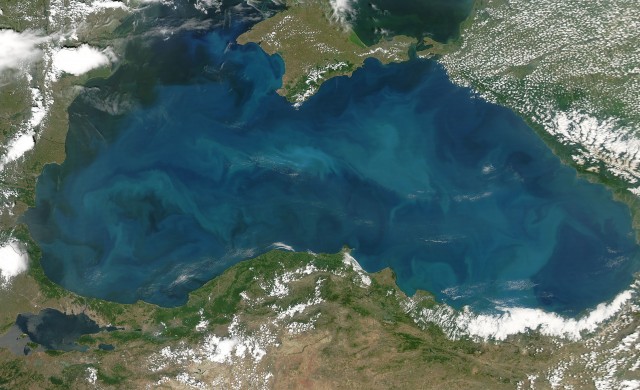Black Sea
THE BLACK SEA IS a body of salt water that stretches 630 mi (1,014 km) from east to west. TURKEY faces its southern shore, BULGARIA and ROMANIA lie west of the Black Sea, and UKRAINE, RUSSIA, and GEORGIA border it to the north, northeast, and east, respectively. The Black Sea stretches 330 mi (530 km) from north to south, except between the Crimean Peninsula and Turkey, where it cinches to 144 mi (232 km).
From the southwest, the Bosporus connects the Black Sea to the Sea of Marmara, and to the north, just east of the Crimean Peninsula, the Kerch Strait leads to the Sea of Azov. The CAUCASUS MOUNTAINS line the northeastern edge of the Black Sea; the Pontic Mountains are to the south. The Black Sea is usually considered the boundary between Europe and Asia. At its deepest point, the Black Sea reaches a depth of 7,218 ft (2,200 m). It has an area of 262,840 square mi (683,000 square km). Below 660 ft (200 m), the water holds no oxygen, and the Black Sea is therefore the largest anoxic basin in world, with about 90 percent of its water permanently anaerobic. The Black Sea figures in myth and history, dating back thousands of years. In the Voyage of the Argonauts, Jason sails through the narrow Bosporus, with shifting walls that threaten to crush his ship, into the Black Sea.

The sea, named “black” by the Turks for its storms, was the trade passage to Asia for the Egyptians and Greeks. It was important to the growth of Byzantium (now Istanbul) from 600 B.C.E. through the time of the Crusades, when the Byzantine Empire was finally destroyed. The Ottoman Turks controlled the Black Sea from 1453 to 1774.
Over 160 million people live in the area of the Black Sea, and it serves as a thoroughfare for oil tankers and other vessels. The sea's anoxic nature aggravates problems of pollution. The countries bordering the Black Sea, as well as the NORTH ATLANTIC TREATY ORGANIZATION (NATO) and other groups, are identifying the problems and proposing improvements in the ecosystems of the region.
In the 1990s, two geologists at Columbia University in New York City, William Ryan and Walter Pitman, proposed a new theory: that the Black Sea had been a freshwater lake until 5000 B.C.E. The MEDITERRANEAN SEA swelled, flooded northward over Turkey, and funneled through the Bosporus Strait with an impact greater than 200 times the force of Niagara Falls. During this flood, which is recalled in the Bible, the Gilgamesh Epic of Sumer, and other ancient stories, the Black Sea rose at a rate of 6 in (15 cm) a day. Dr. Robert Ballad, discoverer of the Titanic remains in 1986, headed an exploratory team in 1999 and 2000 that found evidence of an ancient shoreline 550 ft (168 m) below the current level of the Black Sea. Preliminary dating of sediment supports the flood theory of Williams and Pitman, and Ballard has also found ancient river channels and the remains of a wooden structure 311 ft (95 m) below the current surface.